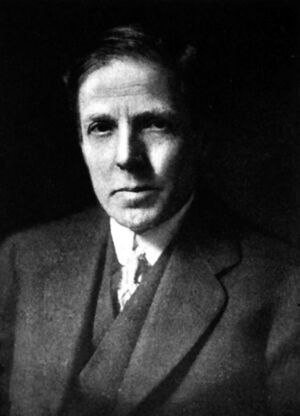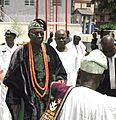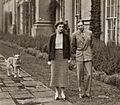Suit (clothing) facts for kids

A suit is a smart outfit that usually includes a jacket and matching trousers (also called pants). Sometimes, a suit also comes with a waistcoat (which Americans call a vest). Suits are often worn for special events or in professional jobs.
When you wear a suit, you usually add other items like nice socks, leather shoes, and a tie. If you don't wear a tie, the outfit is considered more casual. Many people, especially men, wear suits for jobs in business, law, or politics. Women also wear suits, which might include a skirt instead of trousers.
A suit can be part of a dress code, which is a set of rules about what to wear for an event. The best suits are made to fit one person perfectly by a tailor. Suits you buy "off-the-rack" (not custom-made) are cheaper, but they might still need a tailor to adjust them so they fit well.
Contents
What Are the Parts of a Suit?
A suit is made up of a few main pieces that match each other.
The Suit Jacket
The jacket is the top part of the suit. It's usually made from wool, but can also be made from silk, cotton, linen, or polyester. Suit jackets have a collar, pockets, and a smooth lining inside. They come in many colors, but dark blue, brown, and grey are very common.
There are different styles of jackets:
- Double-breasted: These jackets have buttons on both sides of the front.
- Single-breasted: These have buttons down only one side of the front.
- Jackets can also have different numbers of buttons, like two or three.
The Trousers
The trousers (or pants) must match the jacket perfectly. This means they should be made from the same fabric and by the same people. If they don't match, the outfit looks casual. Suit trousers are usually ironed with a sharp crease down the front.
The Waistcoat
A waistcoat (or vest) is a sleeveless top worn under the jacket. It can be made from the same fabric as the suit or from a different, fancier material like silk.
How to Wear a Suit
Besides the main parts of the suit, you also need accessories to complete the look.
Shirts
The shirt worn with a suit is usually made of silk, cotton, or linen. It often has a stiff collar and is ironed. While white shirts are common, shirts worn with suits can be other colors, but they usually have a simple, classic style.
Ties
A tie is almost always worn with a suit. Ties are often made of silk or polyester and come in many colors and patterns. Sometimes, people wear a bow tie instead of a regular tie, or no tie at all for a more relaxed look.
Other Accessories
- If you don't wear a waistcoat, you might wear a thin, sleeveless wool sweater with a V-neck.
- Socks are often made of silk, cotton, or a mix. They are usually dark colors like black, dark blue, or grey.
- Shoes are typically made of leather, often in dark colors like black or brown. They are usually polished to look shiny.
Suits Around the World
How people wear suits can change depending on where they are. In places like northern Europe and the eastern United States (especially New York), suits are often worn in a more formal way. In warmer places like southern Europe and the western United States, styles can be more relaxed. For example, ties are worn less often in warmer climates, and suit colors might be brighter.
The suit has become a standard outfit in international politics and business almost everywhere. However, leaders in some countries, like those in the Middle East or some African nations, might choose to wear traditional clothing instead. This can be a way to show their country's independence and unique culture.
Suits can be expensive, especially if they are custom-made to fit perfectly. This is one reason why ordinary people wear them less often today compared to 50 years ago. Suits are good for office work or formal events, but not for casual activities like watching a football match. Even though casual clothing became more popular in the 1960s and 1970s, important people still often wear suits. Many believe that wearing a suit "says" something about the person, showing they are serious or have high status.
The History of Suits
The modern suit started to develop in the early 1800s. A man named Beau Brummell made changes to formal English men's clothing. More changes were made by tailors in London and other places during the 1800s. By the end of that century, photographs show men wearing suits that look very similar to the ones we see today.
Images for kids
-
Former US Secretary of State Condoleezza Rice and Turkish President Abdullah Gül wearing Western-style business suits.
-
The Oba is a spiritual leader in Nigerian culture with the respect (status) of royalty. This was a ceremony celebrating the 50th anniversary of the Nigerian Navy.
-
A man dressed in a three-piece suit and bowler hat.
-
Prince George, Duke of Kent in the early 1930s wearing a double-breasted suit with only the bottom buttons fastened
-
Angélica Rivera wearing a modern-day skirt suit
See also
 In Spanish: Traje para niños
In Spanish: Traje para niños














